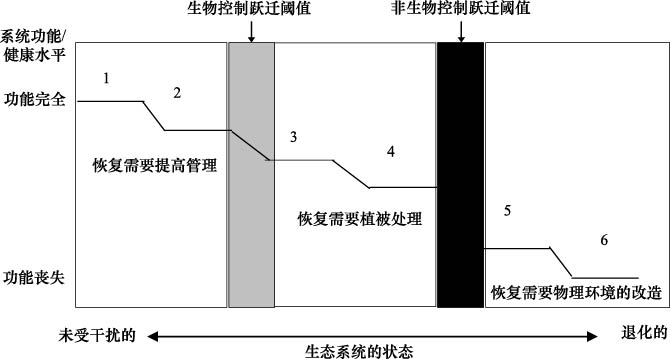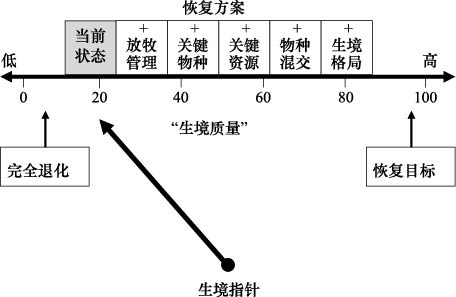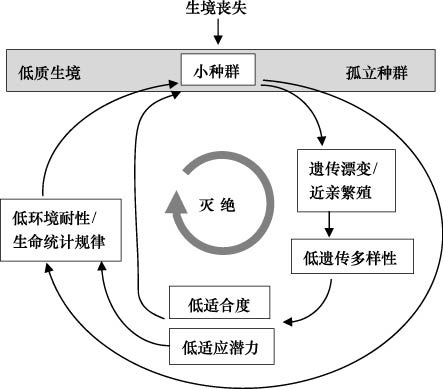文章信息
- 任海, 王俊, 陆宏芳
- REN Hai, WANG Jun, LU Hongfang
- 恢复生态学的理论与研究进展
- Theories and research advances of restoration ecology
- 生态学报, 2014, 34(15): 4117-4124
- Acta Ecologica Sinica, 2014, 34(15): 4117-4124
- http://dx.doi.org/10.5846/stxb201305301238
-
文章历史
- 收稿日期:2013-5-30
- 网络出版日期:2014-3-3
自工业革命以来,由于人口剧增、过垦、过牧及毁林等不合理的活动,以及工业化过程所产生的土地利用变化及各种污染物的影响,再加上全球变化的影响,使得生态系统大面积严重退化,它们提供产品和各种服务功能的能力也受到了极大的损害。这些退化生态系统的存在,将可能影响人类的可持续发展[1, 2],极需要进行生态恢复(ecological restoration)。生态恢复是指帮助那些退化、受损或毁坏的生态系统恢复的过程[3]。与生态恢复相关的术语有重建(rehabilitation)、复垦(reclamation)、 改进(enhancement)、修复(remediation)、舒缓(mitigation)、 重造(creation)、更新(regeneration)、再植(recovery,revegetation)、再造林(reforestation)、生态工程(ecological engineering)等。恢复生态学是研究生态恢复的生态学原理和过程的科学,自1987年诞生以来发展迅速[4, 5]。本文在简介恢复生态学理论的基础上,从生境、种群、群落、生态系统、景观等尺度层面介绍恢复生态学相关进展与主流认识,并对其发展障碍及发展趋势进行了评述,以期为恢复生态学的理论研究与生态实践提供参考。
1 恢复生态学的理论 1.1 来自于生态学的理论生态恢复实践或恢复生态学研究中常用的生态学理论有:生态因子作用(包括主导因子、耐性定律、最小量定律等)、竞争(关于种间资源竞争)、生态位(供恢复用的种类选择和参考群落)、演替(生态恢复是帮助生态系统实现自己的演替)、定居限制(主要是帮助种类在恢复早期克服定居困难)、护理效应(某些种类对其它种类的帮助)、互利共生(真菌、种子扩散者或传粉者与植物间的正相互作用)、啃食/捕食限制(影响植物种群的更新)、干扰(使某些系统的组成变化而需要恢复)、岛屿生物地理学(表明面积更大和连接更多可以帮助恢复)、生态系统功能(生态系统中的能流与物流是生态系统稳定的基础)、生态型(适应相应的环境时可增加恢复成功率)、遗传多样性(遗传多样性高的群落会有更大的进化潜力和长期繁荣)。从上述理论内容看,竞争和定居限制理论是恢复生态学的基础。近来,生态型和区域遗传多样性、健康生态系统中的干扰也已进入生态恢复主流视野[5, 6, 7, 8]。此外,植被连续变化准则、异质种群动态、尺度的概念、正反馈在生态恢复中的作用、启动自然恢复的途径等也被用于生态恢复领域[9]。
1.2 在自身发展过程中产生的理论状态过渡模型及阈值(即恢复的概念模型)。早期的恢复生态学理论主要参考演替理论,认为生态系统处于静止的、单一的、稳定的状态,生态恢复也就是恢复成历史上的某个状态,Bradshaw[10]据此提出的退化生态系统恢复过程中结构与功能变化曲线的模型[11]。现代生态学认为生态系统是一个不断变化的、非线性的、具有非平衡态且具有多稳定状态,不同稳定态之间有阈值存在。Allen[12]提出了经典的恢复的状态和跃迁模型,但这类恢复必须是在生物种类损失不多、生态系统功能受损不严重的生态系统上面。如果生态系统受损超越了受生物或非生物因子控制的不可逆的阈值,生态系统恢复将遵循Whisenant所提出的更复杂的恢复状态和跃迁模型(图 1)[13],该图显示生态退化是分步完成的,而且要跨越被生物或非生物控制的跃迁阈值。Hobbs和Norton[14]和Allen[15]提出了更具普遍性的状态和跃迁模型,假设生态系统存在多种状态,生态系统在退化过程中就会涉及到退化阻力。后来,Whisenant[16]和King和Hobbs[17]又提出三阈值模型,主要不同是在非生物阈值后面加上了个生物-非生物反馈阈值。Bestelmeyer[18]根据格局、过程和退化的关系提出了一个阈值体系,该体系将阈值分为格局阈值、过程阈值和退化阈值。此外,Zedler[19]在研究了大量恢复实例的基础上提出了生态恢复谱理论。
集合规则 由于生态恢复的目标是重组一个系统,因而其成分间的组合很重要。集合规则理论认为一个植物群落的物种组成基于环境和生物因子对区域物种库中植物种的选择与过滤的组合规则,它意味着生物群落中的种类组成是可以解释和预测的。已有研究表明:物种库包括了区域、地方和群落物种库3个层次,集合规则主要显示在群落中哪个种能发生和哪些组合是不相联系的等方面的限制或环境过滤;群落的集合规则有生态位相关的过程、物种是平等的中性过程、特化和扩散过程3种解释;生物间相互作用的集合规则主要基于物种和功能群等生物组分的频率;而生物间及生物与非生物环境因子间相互作用的集合规则强调基于确定性、随机性及多稳态模型的生态系统结构和动态响应,这更符合生态恢复[8, 20]。
参考生态系统 生态恢复最重要的内容之一是确定恢复的目标。生态恢复时选定参考生态系统不只是参考其结构,还包括其发展过程中的任何状态。过去认为恢复的目标是一组明确可行的生态系统参考指标或某一个参考系统。目前认为环境的随机性和全球变化会导致不确定性,而且恢复的目标是参考生态系统多个变量及各个变量一定的变化范围[21]。对于没有参考时,则要从过去存在的又可获得的信息和知识中提取正常功能和历史变异范围,生态系统中的生态记忆可以为生态恢复提供参考[22]。
人为设计和自我设计 人为设计和自我设计理论是从恢复生态学中产生的理论,并在生态恢复实践中得到广泛应用。人为设计理论认为:通过工程方法和植物重建可直接恢复退化生态系统,但恢复的类型可能是多样的。这一理论把物种生活史作为植被恢复的重要因子,并认为通过调整物种生活史方法可以加快植被恢复。而自我设计理论认为:只要有足够的时间,随着时间的进程,退化生态系统将根据环境条件合理地组织自己,并会最终改变其组分。这两种理论不同点在于:人为设计理论把恢复放在个体或种群层次上考虑,恢复的结果可能有多种;而自我设计理论把恢复放在生态系统层次考虑,认为恢复完全由环境因素所决定[7]。
适应性恢复 据Moreno-Mateos 等[23]对全球621个湿地恢复案例的分析,即使有一定年限的恢复,相对于参考生态系统,也有只23%—26%的生物结构(主要由植物集合驱动)和生物地球化学功能(主要由土壤碳库驱动)恢复。可见,生态系统是很难完全恢复的,因为它有太多的组分,而且组分间存在非常复杂的相互作用。此外,在生态系统恢复过程中,由于物理及生态环境及社会经济因素发生变化,对生态系统的认识也要发生变化,在恢复过程中要考虑恢复的目标与措施进行适应性生态恢复[24]。也就是说,恢复的目标的确定要根据生态、经济和社会现实;不是重建历史上的系统状态,而是帮助系统获得自我发展和维持的能力[25]。
2 恢复生态学研究中的一些进展与认识 2.1 生境恢复生境是指某个种的个体或群体为完成生命过程需要的、在一定面积上的资源和环境条件的联合体,近来也有指同类的植被或土地覆盖类型。生境恢复的目标受生态的、社会的、经济的、历史的和哲学观的影响,有些生境恢复甚至还要考虑与先锋种、区域内的干扰相匹配。恢复的生境要考虑物种特征的生境要求(食物要求、庇护/繁殖要求、移动/扩散能力、对环境的反应能力、与其它种的种间关系),在斑块内的特征(植被结构、种类组成、关键资源、地表覆盖),以及在景观上的特征(斑块的大小与形状、资源的距离、连接度、基底特征)[8, 26, 27, 28]。生境恢复的过程可以看作是某个区域从一个低质量生境的退化状态向高质量生境的改进过程(图 2)[26]。
种群恢复主要研究如下5个方面的内容:原始种群的个体数量、遗传多样性对种群定居、建立、生长和进化潜力的影响;地方适应性和生活史特征在种群成功恢复中的作用;景观元素的空间排列对复合种群动态和种群过程(如迁移)的影响;遗传漂变、基因流和选择对种群在一个经常加速、演替时间框架内持久性的影响;种间相互作用对种群动态和群落发展的影响[29]。
典型的种群尺度的生态恢复就是物种回归,它是指在迁地保护的基础上,通过人工繁殖把植物引入到其原来分布的自然或半自然的生境中,以建立具有足够的遗传资源来适应进化改变、可自然维持和更新的新种群[30, 31]。
种群恢复的理论来自种群生态学和复合种群理论。一般认为,种群的命运由种群统计学参数、环境参数、遗传因子及它们的相互作用决定,生境破坏和破碎化会导致常住种种群减小和增加居群间隔离,进而导致迁移和基因流的减少(图 3)[32],而事实上,地方种群通过形态可塑性和适应性遗传分化两种方式来适应环境及其变化。适应性遗传分化导致地方适应,基因流限制会引起近亲繁殖和遗传漂变,而这又会导致小种群平均适合度的降低。因此,在恢复生态学中要考虑通过遗传挽救来避免低适合度种群。遗传多样性恢复不仅包括遗传挽救,还包括增加基因流而影响中性变异和适应性变异。因此,在恢复时要考虑种子转移区的种源原则,即在乡土种的个体(种子、幼苗、成年植株)的地理分布内的移植。另要考虑关键种的影响可能会超越种群水平,产生扩展的表型效应,这种效应能影响生态系统诸如氮矿化、凋落物分解和与植物相连的昆虫群落结构等过程[8]。
2.3 群落恢复群落尺度上的恢复最关注如下问题:最接近自然的恢复终点要强调群落的功能(如营养结构)而不是特定的物种。虽然用物种和多样性来衡量恢复较为简单,但事实上在群落中重建所有的乡土种几乎是不可能的,有时甚至可以考虑用恢复哪些植物功能特征来代替恢复哪些物种。物种多样性与群落稳定性有关系,但也要考虑在区域物种库中有些种类是功能冗余的。植物群落在种群建立过程中存在定居限制,通过护理植物的方式可以解除部分定居限制[33, 34]。生境恢复要考虑到能够满足物种及其功能恢复的需要,而不只是种类恢复。可以利用群落演替和扩散理论来调控自然演替过程并促进恢复[35]。通过自然演替方式恢复原始林很困难是因为存在环境条件及定居限制,而且这些限制因子因种而异,这种种类依赖性又由功能群决定[36, 37]。此外,生物群落由生物与环境相互作用以及各种生物间的相互影响而形成,因而在群落恢复中要考虑生物群落的直接相互作用(消费、寄生、生态系统工程师、化感作用)、互利共生(植物-真菌相互作用、植物-传粉者相互作用)和间接相互作用[8]。
2.4 生态系统恢复生态系统尺度的恢复主要是“重建参考生态系统中发生的物种间有一定特征的组合”,SER指出了恢复了的生态系统必须具有的结构、功能和动态方面的9个特征,其中最主要还是考虑生态系统功能的恢复[3]。生态系统恢复过程中,地上部分与地下部分的联接与生态过程的恢复由植物、动物和微生物等生物组分功能特征谱决定。事实上,植物与土壤间的反馈作用随时间的变化会驱动乡土种恢复并控制恢复/演替过程[38],土壤的物理、化学和生态学结构对地下的能流和物流影响很大[39],但目前对地下生态学过程的研究远不如地上生态学过程研究,例如土壤中的无脊椎地动物了解就不多。
生态系统恢复更强调动态平衡、非线性、多样性与稳定性的关系、结构功能与动态的协调性,还要考虑冗余性和生态网络的恢复[40],因此,国际恢复生态学会提出恢复的生态系统应该是复原性的,具有复原性和复杂性[3]。
同时要考虑它在景观背景下与其它生态系统的边界、连接性、能量与物质流动态、物理环境等问题[8]。在恢复生态系统时,系统内部要重点考虑营养、污染和能量的收支、输入的胁迫效应、食物网的结构、植物与传粉者间的网络关系、生态系统组分间的反馈作用、养分转移效率、初级生产力和系统分解率以及干扰体系[41]。
2.5 恢复的景观尺度景观生态学主要关注比生态系统尺度更大的时空上的问题,强调景观结构、格局、过程、动态与可持续性。景观生态学中的岛屿生物地理学理论和生态水文知识被广泛应用于恢复生态学领域,并导致这两个新兴学科间的联系日益紧密。需要恢复的生态系统与生物群落或种群是在一定的时空尺度下生存的,与之相关的自然过程与各种干扰也是;因此,生态保护与生态恢复项目都要考虑尺度效应[42]。景观生态学有关原理可以为评估退化生态系统的生境功能及破碎化、生态恢复提供参考生态系统及目标,在为植物或动物提出利于定居的空间格局安排方面有重要的作用,但在大尺度生态恢复中的指数选取、量化与预测性方面还有限[43]。未来,景观生态学中的格局与过程、景观连接度和破碎化、尺度中的等级理论、土地利用的影响、生态系统服务功能、景观可持续性等理论将在恢复生态学中有更广阔的应用[44]。
2.6 全球变化与人类干扰要纳入生态恢复范畴已有证据表明全球变化越来越明显,它已经对全球各类生态系统的结构与功能、产品和生态系统服务产生影响[45]。全球变化对生态恢复的实践与产出有潜在的、重要的影响,至少要恢复历史上的生态系统条件已不太可能;因此,在全球变化的背景下,生态恢复要在重建过去的系统与将来的回复性系统间保持一个平衡[46]。
由于人类对世界各类生态系统的影响已很大且不可避免,人类在恢复过程中又要考虑经济利益,因而人类会更关注生态系统服务功能的恢复以及投入产出的经济效益。生态系统在各种自然和人为干扰后,其恢复的时间和空间尺度有所不同,因而自然和人类的干扰应纳入生态恢复范畴[47]。
由于人类干扰,许多生态系统快速变成了新的、非历史性的新奇生态系统。这种新系统可能会导致生态系统生物组分的变化(如灭绝或入侵)、非生物的变化(如土地利用和气候变化)以及生物和非生物的联合作用。这些变化可能会导致历史生态系统和新奇生态系统间的杂合系统保留一些原始特征和新的元素,在新奇生态系统中则由完全不同的生物、种间作用和功能组成。新奇生态系统的存在将引起传统保护和恢复生态学的理论与方法的新思考[48]。
3 发展的障碍与趋势恢复生态学中,陆地的研究远不及水生和湿地的研究深入[49, 50]。从宏观上看,恢复生态学发展主要有两个障碍:一是目前恢复生态学还是一个验证性的科学,主要处理少变量因子和这些因子的部分层次的简单实验,缺乏复杂的、多变量、复杂数量分析方法的实验;另一个是短视性的学术研究导致的少量的合成和弱的概念理论,这需要更好地认识和明确生态学原理[49]。
从微观上看,当前的生态恢复过程分强调养分及物种的还原,而忽视水文学过程、以及养分循环及能量获得过程;过分注重具体的生境而忽略景观;将恢复作为工作的结束而不是作为自发修复的开始。未来应该考虑以生态过程调控为主,诱导生态系统的正反馈的自发恢复,考虑生境景观间的相互作用[51]。
从恢复生态学的历程看,当前恢复生态学的研究已从静态研究、单一状态研究、基于结构的方法和集中于某一类型生态系统研究等特征转向动态研究、多状态研究、基于过程的方法和多维向恢复评价标准等特征[7, 9]。其研究热点包括:从生态系统的角度评估生态系统退化、恢复过程中的非生物与生物障碍、恢复中的关键过程(授粉、扩散、火灾、养分循环等)的时空动态[52]、生态恢复中不可逆转的阈值、物种间相互作用及其在区域间的转移、“神秘”的生物群(真菌、根瘤菌、土壤原生动物等)在恢复中的作用、注重生物连接性的生物多样性产出、地上与地下作用及反馈、以生态系统尺度为基础上强调景观尺度及交错带的生态恢复、景观中的廊道和连接性问题在生态恢复中的作用、国际恢复生态学会提出的生态恢复的9个特征、自然资本的恢复、恢复生态产品与生态系统服务、基于乡土植被及养分管理的恢复设计、气候变化背景下的生态恢复问题、生态恢复过程中的经济过程等领域[53, 54, 55, 56, 57, 58]。此外,恢复生态学还与当前比较热门的政治问题,如C排放与交易、生物多样性丧失、生态系统服务功能支付等紧密相连[59, 60, 61, 62]。未来恢复生态学要把实践和理论相结合,需要多学科相结合,把自然科学和人文科学中的社会、经济、文化、政治等因素相结合,最终实现可持续发展[59, 60]。
致谢: 美国USDA FS-Eastern Forest Threat Center的Qinfeng Guo博士润色英文摘要,特此致谢。
| [1] | MEA (The millennium ecosystem assessment). 2005. http://www.millenniumassessment.org//En/Products.aspx. |
| [2] | Ren H, Shen W, Lu H, Wen X, Jian S. Degraded ecosystems in China: Status, causes, and restoration efforts. Landscape and Ecological Engineering, 2007, 3(1): 1-13. |
| [3] | Society for Ecological Restoration International (SER). The SER Primer on Ecological Restoration. 2004. http://www.ser.org/content/ecological_restoration_primer.asp. |
| [4] | Ren H, Peng S L. Introduction of Restoration Ecology. Beijing: Science Press, 2001. |
| [5] | Young T P, Petersen D A, Clary J J. The ecology of restoration: historical links, emerging issues and unexplored realms. Ecology Letters, 2005, 8(6): 662-673. |
| [6] | Peng S L. Restoration Ecology. Beijing: China Meteorological Press, 2007. |
| [7] | Ren H, Liu Q, Li L H. Introduction of Restoration Ecology. 2nd ed. Beijing: Science Press, 2008. |
| [8] | van Andel J, Aronson J. Restoration Ecology: The New Frontier. 2nd ed. Oxford: Wiley-Blackwell, 2012. |
| [9] | Wu X Y, Liu F, Whisenant S G. Advances in restoration ecology a North American perspective//Wu J G, ed. Lectures in Modern Ecology (Ⅲ): Advances and Key Topics. Beijing: Higher Education Press, 2007: 285-306. |
| [10] | Bradshaw A D. The reconstruction of ecosystems: presidential address to the British ecological society, December 1982. Journal of Applied Ecology, 1983, 20(1): 1-17. |
| [11] | Didham R K, Norton D A. When are alternative stable states more likely to occur? Oikos, 2006, 113(2): 357-362. |
| [12] | Allen E B. The restoration of disturbed arid landscapes with special reference to mycorrhizal fungi. Journal of Arid Environments, 1989, 17: 279-286. |
| [13] | Whisenant S G. Repairing Damaged Wildlands: A Process-Orientated, Landscape-Scale Approach. Cambridge: Cambridge University Press, 1999. |
| [14] | Hobbs R J, Norton D A. Towards a conceptual framework for restoration ecology. Restoration Ecology, 1996, 4(2): 93-110. |
| [15] | Allen J R L. Morphodynamics of Holocene salt marshes: a review sketch from the Atlantic and southern North Sea coasts of Europe. Quaternary Science Review, 2000, 19(12): 155-231. |
| [16] | Whisenant S G. Terrestrial Systems//Perrow M, Davy A, eds. Handbook of Ecological Restoration. Volume 1, Principles of Restoration. Cambridge: Cambridge University Press, 2002, 83-105. |
| [17] | King E G, Hobbs R J. Identifying linkages among conceptual models of ecosystem degradation and restoration: towards an integrative framework. Restoration Ecology, 2006, 14(3): 369-378. |
| [18] | Bestelmeyer B T. Threshold concepts and their use in rangeland management and restoration: the good, the bad, and the insidious. Restoration Ecology, 2006, 14(3): 325-329. |
| [19] | Zedler J B, Callaway J C. Tracking wetland restoration: do mitigation sites follow desired trajectories? Restoration Ecology, 1999, 7(1): 69-73. |
| [20] | Temperton V M, Hobbs R J, Nuttle T, Halle S. Assembly Rules and Restoration Ecology: Bridging the Gap between Theory and Practice (The Science and Practice of Ecological Restoration Series). Washington, DC: Island Press, 2004. |
| [21] | Egan D, Howell E. The Historical Ecology Hand-book: A Restorationist's Guide to Reference Ecosystems. Washington, DC: Island Press, 2001. |
| [22] | Sun Z Y, Ren H, Schaefer V, Lu H F, Wang J, Li L J, Liu N. Quantifying ecological memory during forest succession: a case study from lower subtropical forest ecosystems in South China. Ecological Indicators, 2013, 34: 192-203. |
| [23] | Moreno-Mateos D, Power M E, Comín F A, Yockteng R. Structural and functional loss in restored wetland ecosystems. PLoS Biology, 2012, 10(1): e1001247. |
| [24] | Zedler J B, Kercher S. Wetland resources: status, trends, ecosystem services, and restoration. Annual Review of Environment and Resources, 2005, 30(1): 39-74. |
| [25] | Halle S. Science, art, or application-the "Karma" of restoration ecology. Restoration Ecology, 2007, 15(2): 358-361. |
| [26] | Miller J R, Hobbs R J. Habitat restoration-do we know what we're doing? Restoration Ecology, 2007, 15(3): 382-390. |
| [27] | Ren H, Li Z A, Shen W J, Yu Z Y, Peng S L, Liao C H, Ding M M, Wu J G. Changes in biodiversity and ecosystem function during the restoration of a tropical forest in south China. Science in China Series C: Life Sciences, 2007, 50(2): 277-284. |
| [28] | Sherkow J S, Greely H T. Comments on "What If Extinction Is Not Forever?". Science, 2013, 340(6128): 32-33. |
| [29] | Montalvo A M, Williams S L, Rice K J, Buchmann S L, Cory C, Handel S N, Nabhan G P, Primack R, Robichaux R H. Restoration biology: a population biology perspective. Restoration Ecology, 1997, 5(4): 277-290. |
| [30] | Maunder M. Plant reintroduction: an overview. Biodiversity and Conservation, 1992, 1(1): 51-61. |
| [31] | Ren H, Zhang Q M, Lu H F, Liu H X, Guo Q F, Wang J, Jian S G, Bao H. Wild plant species with extremely small populations require conservation and reintroduction in China. AMBIO, 2012, 41(8): 913-917. |
| [32] | Frankham R, Ballou J D, Briscoe D A. Introduction to Conservation Genetics. 2nd ed. Cambridge: Cambridge University Press, 2005. |
| [33] | Gómez-Aparicio L, Zamora R, Gómez J, Hódar J, Castro J, Baraza E. Applying plant facilitation to forest restoration: a meta-analysis of the use of shrubs as nurse plants. Ecological Applications, 2004, 14(4): 1128-1138. |
| [34] | Ren H, Yang L, Liu N. Nurse plant theory and its application in ecological restoration in lower subtropics of China. Progress in Natural Science, 2008, 18(2): 137-142. |
| [35] | Palmer M A, Ambrose R F, Poff N L. Ecological theory and community restoration ecology. Restoration Ecology, 1997, 5(4): 291-300. |
| [36] | Wang J, Ren H, Yang L, Duan W J. Establishment and early growth of introduced indigenous tree species in typical plantations and shrubland in South China. Forest Ecology and Management, 2009, 258(7): 1293-1300. |
| [37] | Asanok L, Marod D, Duengkae P, Pranmongkold U, Kurokawaa H, Aibaa M, Katabuchia M, Nakashizukaa T. Relationships between functional traits and the ability of forest tree species to reestablish in secondary forest and enrichment plantations in the uplands of northern Thailand. Forest Ecology and Management, 2013, 296: 9-23. |
| [38] | Yelenik S G, Levine J. The role of plant-soil feedbacks in driving native-species recovery. Ecology, 2011, 92(1): 66-74. |
| [39] | Heneghan L, Miller S P, Baer S, Callaham M A Jr, Montgomery J, Pavao-Zuckerman M, Rhoades C C, Richardson S. Integrating soil ecological knowledge into restoration management. Restoration Ecology, 2008, 16(4): 608-617. |
| [40] | Pocock M J O, Evans D M, Memmott J. The robustness and restoration of a network of ecological networks. Science, 2012, 335(6071): 973-977. |
| [41] | Ehrenfeld J G, Toth L A. Restoration ecology and the ecosystem perspective. Restoration Ecology, 1997, 5(4): 307-317. |
| [42] | Ren H. Plantations: Biodiversity, Carbon Sequestration, and Restoration. New York: Nova Science Publishers, 2013. |
| [43] | Peng S L, Zhou T, Liang L Y, Ren W T. Landscape pattern dynamics and mechanisms during vegetation restoration: a multiscale, hierarchical patch dynamics approach. Restoration Ecology, 2012, 20(1): 95-102. |
| [44] | Wu J G. Key concepts and research topics in landscape ecology revisited: 30 years after the Allerton Park workshop. Landscape Ecology, 2013, 28(1): 1-11. |
| [45] | Walker B, Salt D. Resilience Thinking: Sustaining Ecosystems and People in a Changing World. Washington, D. C: Island Press, 2006. |
| [46] | Harris J A, Hobbs R J, Higgs E, Aronson J. Ecological restoration and global climate change. Restoration Ecology, 2006, 14(2): 170-176. |
| [47] | Dobson A P, Bradshaw A D, Baker A J M. Hopes for the future: restoration ecology and conservation biology. Science, 1997, 277(5325): 515-522. |
| [48] | Hobbs R J, Higgs E, Harris J A. Novel ecosystems: Implications for conservation and restoration. Trends in Ecology & Evolution, 2009, 24(11): 599-605. |
| [49] | Weiher E. On the status of restoration science: obstacles and opportunities. Restoration Ecology, 2007, 15(2): 340-343. |
| [50] | Song X L, Lü X G. A review on the ecological restoration of degraded estuarine wetlands in China. Wetland Science, 2009, 7(4): 379-384. |
| [51] | Whisenant S G. Repairing Damaged Wildlands: A Process-Oriented, Landscape-Scale Approach. Cambridge: Cambridge University Press, 1999. |
| [52] | McDonald T, Williams J. A perspective on the evolving science and practice of ecological restoration in Australia. Ecological Management & Restoration, 2009, 10(2): 113-125. |
| [53] | Wu D D, Cai Y L. Evaluation of ecological restoration effects in China: A review. Progress in Geography, 2009, 28(4): 622-628. |
| [54] | Yu Y N, Peng S L. Ecological restoration Economics. Acta Ecologica Sinica, 2009, 29(8): 4441-4447. |
| [55] | Dang X H, Liu G B, Xue S. Models of soil and water conservation and ecological restoration in the loess hilly region of China. Transactions of the Chinese Society of Agricultural Engineering, 2010, 26(9): 72-80. |
| [56] | Ma J M, Liu S R, Shi Z M, Liu X L, Miu N. A review on restoration evaluation studies of degraded forest ecosystem. Acta Ecologica Sinica, 2010, 30(12): 3297-3303. |
| [57] | Jiang G M, Liu M Z, Niu S L, Li Y G, Peng Y, Li G, Su B Y. Ten-year-period demonstration project in Hunshandake sandland and prospect for the future development of eco-stock farming industry. Science & Technology Review, 2011, 29(25): 19-25. |
| [58] | Hu Z Q, Wang P J, Li J. Ecological restoration of abandoned mine land in China. Journal of Resources and Ecology, 2012, 3(4): 289-296. |
| [59] | Temperton V M. The recent double paradigm shift in restoration ecology. Restoration Ecology, 2007, 15(2): 344-347. |
| [60] | Cabin R J, Clewell A, Ingram M, McDonald T, Temperton V. Bridging restoration science and practice: results and analysis of a survey from the 2009 society for ecological restoration international meeting. Restoration Ecology, 2010, 18(6): 783-788. |
| [61] | Suding K N. Toward an era of restoration in ecology: successes, failures, and opportunities ahead. Annual Review on Ecology, Evolution and Systematic, 2011, 42(1): 465-487. |
| [62] | Tibbett M, Audet P. Recent advances in restoration ecology: Examining the modern Australian agro-ecological and post-mining landscapes. Agriculture, Ecosystems and Environment, 2012, 163: 1-2. |
| [4] | 任海, 彭少麟. 恢复生态学导论. 北京: 科学出版社, 2001. |
| [6] | 彭少麟. 恢复生态学. 北京: 气象出版社, 2007. |
| [7] | 任海, 刘庆, 李凌浩. 恢复生态学导论 (第二版). 北京: 科学出版社, 2008. |
| [9] | 武昕原, 刘峰, Whisenant S G. 恢复生态学进展——北美视角 // 邬建国. 现代生态学讲座(III)学科进展与热点论题. 北京: 高等教育出版社, 2007: 285-306. |
| [50] | 宋晓林, 吕宪国. 中国退化河口湿地生态恢复研究进展. 湿地科学, 2009, 7(4): 379-384. |
| [53] | 吴丹丹, 蔡运龙. 中国生态恢复效果评价研究综述. 地理科学进展, 2009, 28(4): 622-628. |
| [54] | 虞依娜, 彭少麟. 生态恢复经济学. 生态学报, 2009, 29(8): 4441-4447. |
| [55] | 党小虎, 刘国彬, 薛萐. 中国黄土丘陵区水土保持与生态恢复模式. 农业工程学报, 2010, 26(9): 72-80. |
| [56] | 马姜明, 刘世荣, 史作民, 刘兴良, 缪宁. 退化森林生态系统恢复评价研究综述. 生态学报, 2010, 30(12): 3297-3303. |
| [57] | 蒋高明, 刘美珍, 牛书丽, 李永庚, 彭羽, 李刚, 苏本营. 浑善达克沙地10年生态恢复回顾与展望. 科技导报, 2011, 29(25): 19-25. |
| [58] | 胡振琪, 王培俊, 李晶. 中国矿山迹地的生态恢复. 资源与生态学报, 2012, 3(4): 289-296. |
 2014, Vol. 34
2014, Vol. 34







